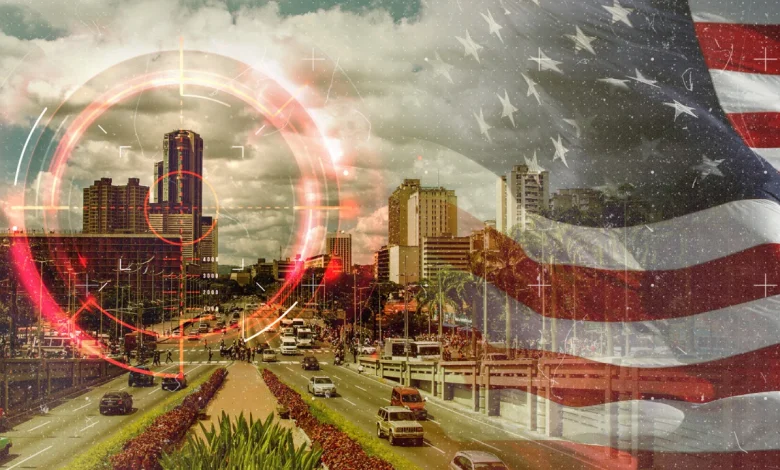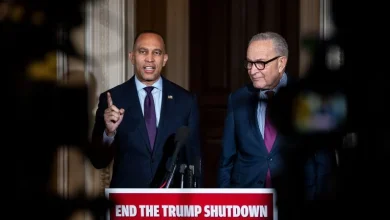Not-so-covert ops: Has Trump set his sights on Venezuela’s Nicolas Maduro?

On the afternoon of September 19, an Airbus plane used by Venezuelan President Nicolas Maduro took off from Caracas. But 20 minutes later, it abruptly looped back.
A plane spotter on X posted a screenshot of a flight-tracking map that showed the presidential Airbus making a U-turn.
A short while earlier, a different post on X caught the attention of online sleuths. Marshall Billingslea, a former assistant secretary for terrorism financing at the US Treasury, had posted two photos of the same man. In one of the photographs, the man was sitting on a red leather couch with a smile on his face. The other was a formal photo of him in uniform, decorated with badges.
“¡Feliz cumpleaños “General” Bitner!” Billingslea wrote on X alongside the pictures, wishing a happy birthday to General Bitner Villegas – Maduro’s longtime trusted pilot and the man believed to have been flying the plane.
A screenshot of a tweet by Marshall Billingslea, a former assistant secretary for terrorism financing at the US Treasury ©
This bizarre post may have been the reason for the flight’s abrupt diversion, an investigation by the Associated Press published on October 28 reveals. The exposé posits that Villegas may have been at the centre of a CIA-led covert operation targeting the Venezuelan president. The AP reviewed – and authenticated – text exchanges between the pilot and Department of Homeland Security (DHS) agent Edwin Lopez.
The plan was supposed to be simple. The DHS sought to recruit Villegas to help arrest Maduro, Venezuela’s president since 2013 and “one of the largest narco-traffickers in the world” according to the United States. Trump has been a long-time critic of Maduro, who returned to office in January after an election that was widely rejected by the international community and fraught with allegations of fraud.
Read moreThe fake news circulating about Nicolás Maduro’s re-election in Venezuela
The investigation by the Associated Press is replete with all the elements that make a pulp spy novel: luxury jets, clandestine meetings and blackmail between two of the most powerful figures in the Americas. It reveals the extent to which the US is willing to go to topple the Maduro, who is accused of destroying the oil-rich nation’s fledgling democracy and providing safe haven for drug traffickers and terrorist groups.
It also shines a light on the haphazard methods of the Trump-era CIA.
Playing on Maduro’s paranoia
The AP exposé alleges that DHS agent Lopez approached Villegas in 2024 after a tip-off about the location of Maduro’s planes. At the time, Lopez was leading investigations into transnational criminal networks after having built a career taking down drug gangs and money-laundering operations.
His offer to Villegas was straightforward: the pilot would surreptitiously divert Maduro’s plane to a territory where the US could legally arrest him. In exchange, he would make the pilot a rich man who would be beloved by many who wish to overthrow the authoritarian Venezuelan leader.
According to AP, the conversation between the men was tense. Villegas was noncommittal but left his cell number with Lopez, who may have taken it as a sign of potential cooperation.
Venezuelan President Nicolás Maduro stands behind pilot Gen. Bitner Villegas in the cockpit of an airplane. © AP
And the “Happy birthday” photo may have helped fuel Maduro’s fears that he was being betrayed.
Neither Washington nor Caracas confirmed the allegations when contacted by the AP.
Lopez reportedly maintained contact with Villegas, even after his retirement in July this year. When Trump increased the reward for capturing Maduro in August this year, the pilot received a message reminding him that there was still time to join forces with the CIA. Lopez told the pilot that there was still time left to be a Venezuelan hero and “on the right side of history”. Lopez attached a link to a Justice Department press release announcing the reward had risen to $50 million.
The pilot ultimately refused to cooperate with US intelligence services and even appeared on Venezuelan television in late September alongside the minister of the interior, who asserted that Villegas is, and always has been, loyal to the president.
Echoes of the past
This isn’t the first time the US has sought to make or break governments in Latin America; US authorities famously spent decades targeting Cuban president Fidel Castro and his entourage.
“There is a very interesting parallel here with a plot in 1960, when a CIA official tried to convince a Cubana Airlines pilot to take down a plane carrying [the president’s brother] Raul Castro,” says Luca Trenta, an intelligence services specialist at Swansea University in Wales.
“They offered him $10,000 or so and said they would pay for the education of his kids,” says Trenta, in case he didn’t survive what could have been a suicide mission. But the pilot didn’t follow through.
“He just came back without having killed Raul Castro or himself,” Trenta says.
The AP report on the CIA’s latest attempt came just after Trump authorised the CIA to conduct clandestine operations in Venezuela last August, signalling ever-greater possibility of future interventions.
Annette Idler, an associate professor at the Blavatnik School of Government at the University of Oxford and a specialist in international security issues, notes that US interventions in Latin America have had a long and troubled history.
“We can start with the overthrowing of Guatemala’s president in 1954 or to supporting anti-Castro operations in Cuba. Then we had the intervention regarding the coup against [Socialist President Salvador] Allende in Chile in 1973, then Nicaragua. The list goes on and on.”
Venezuela’s President Nicolas Maduro in Caracas, Venezuela, October 12, 2025. © Leonardo Fernandez Viloria, Reuters
The CIA’s involvement in Latin America reached a new high during the Cold War-era fight against communism, when the agency participated in the fall of five regimes between 1963 and 1981: Ecuador, Brazil, Chile, Bolivia and Panama. US intelligence also provided financial and operational support to Operation Condor, a campaign of political repression carried out in the 1970s by several right-wing Latin American dictatorships against left-wing opponents.
But Trenta says US intelligence interventions in South America actually peaked between 1981-1989 under Ronald Reagan.
“We returned to a kind of golden age of covert operations, particularly in Central America. Initially it was anti-communism and it transformed into a war on drugs,” he says, adding that the Drug Enforcement Agency is becoming increasingly active in the region.
Read more‘Every reason’ to expect attacks inside Venezuela, expert warns as US escalates operations
Trump is giving the impression of simultaneously being for the status quo – officially, the aim is to combat drug trafficking, of which Venezuela is allegedly a hub – while also raising the spectre of new US efforts to destabilise the Maduro regime through clandestine actions.
But the Donald Trump of 2025 is very different from the Trump of 2016-2020.
“He wants to signal his resolve and his ability to use US power,” Trenta says. During his first term, there were the famous “adults in the room” – career government officials who tried, as best they could, to restrain the president’s more extreme impulses.
The CIA was keen to propose less radical solutions – including a successful cyberattack on the computer network used by Venezuelan intelligence – than what Trump was demanding in his first term, according to a CNN report this week that outlined Trump’s ambitions to oust Maduro.
Not-so-covert operations
The current director of the CIA, John Ratcliffe, is a staunch Trump supporter who, along with Secretary of State Marco Rubio, takes a muscular approach to US policy in Latin America.
“We know Marco Rubio is a hardliner,” Idler says. “And along with other hardliners in this administration, he’s said to have pushed Maduro high up on the agenda.”
What is truly unique about the current escalation of tensions between Washington and Caracas is that everything is being done out in the open, Idler says, adding: “I don’t see what could be clandestine about CIA operations that are almost announced in advance.”
“At least during the Cold War, the United States maintained the possibility of denying any involvement in clandestine operations. This time, that principle of plausible deniability no longer exists,” she says.
Accept
Manage my choices
One of your browser extensions seems to be blocking the video player from loading. To watch this content, you may need to disable it on this site.
Try again
© France 24
This approach defies the basic rules of working as an agent – and may be partly about bluster, Trenta says.
It “demonstrates that the Trump administration has only a very rudimentary understanding of what force projection is,” he says. “For them, it is simply about hitting hard. The rest is for show.”
Idler echoes that sentiment, saying the decision to make normally covert operations public is part of a strategy to convince US citizens that the administration has a strong, tough-on-crime government, rather than actually working to resolve complex international issues.
“Making these clandestine operations public turned them into instruments of domestic signalling rather than effective strategy,” she says. “Trump wants to be seen as a guy being tough on drugs, on crime, on migration.”
But the approach may backfire. Venezuela announced on Monday that it had thwarted a CIA plot, accusing the agency of having established a cell to fabricate “false flag” incidents that could be used to justify a US military intervention.
Both nations could eventually find themselves in a spiralling series of reprisals.
“The risk is that Venezuela could decide to retaliate by launching operations on American soil,” Idler says.
“It invites reciprocal interference.”
This article has been translated from the original in French by Diya Gupta.





